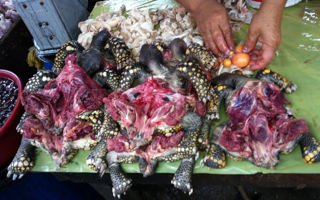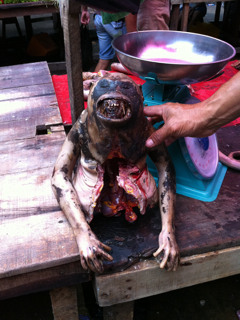This hour’s guest post comes from Dr. Patrick Mahaney, who if you recall was with me on my Amazon Cares adventure to Peru earlier this year. I thought this post showing the horrors we encountered in the Belen Marketplace was more than fitting for this blogathon horror theme. There was some crazy stuff there. I will echo his warning that the photos are graphic.
Warning! This article contains graphic descriptions and photos of slaughtered wildlife.
On my final day on my vets abroad trip to Peru with Amazon Cares, I ventured into truly uncharted territory at the Belen Market. Over the past two weeks, I have had many unsettling experiences, yet the sights, smells, and tastes (in which I did not participate) at this third world street market took the proverbial cake.
Having been warned of the potential dangers lurking in the market, as theft of tourist belongings runs rampant, I kept one hand in my pocket (holding my iPhone) and the other on my waist pack (not making a peace sign, giving a high five, or whatever other Alanis Morrisette inflection which comes to mind). I also stuck close to my fellow volunteers and avoided congested areas where wandering hands could strive for my personal valuables. What I did not expect was the shocking visuals of native wild creatures having been slaughtered and prepared for human consumption.
Being from a first world country, there are established ethical beliefs and anti-cruelty laws that prohibit killing and swelling many wildlife species. In Peru, there is an overriding deficiency in enforced regulations governing the slaughter of alligators, turtles, snakes and even primates which ultimately permits the sale of their carcasses in venues like Belen.
I found myself aghast while walking row after row of vendors offering organ meats, fowl feet, beheaded reptiles, de-shelled ovulating turtles, and even skinned monkey torsos.
These horrific sights readily sent us scurrying for the plant based medicinal section of the market, which featured no apparent use of wildlife in the available products (the Cat’s Claw topical ointment I purchased is purely plant based).
I spoke with one of my advisers from Amazon Cares, which is the organization with which I was doing volunteer veterinary work for dogs and cats in remote Peruvian communities (see Amazon Cares Shelter Dogs Receive Vet Exams and I Love Dogs Supplements and Capturing Treating and Releasing the Street Dogs of Iquitos.
Besides the killed species on display, evidently there are underground venues at Belen where live exotic species, like the Serval, can be purchased. Evidently, the Peruvian government and pro-wildlife organizations do not attempt to govern the situation out of fear for their own safety. I find the lack of government conviction in preventing the slaughter of native wildlife to be appalling, yet not surprising, given that we were in a third world country.
So, I am contacting multiple Peruvian nature and wildlife preservation organizations to see who has the capability to actually make some positive changes regarding the sale of these poor creatures to the public. Please feel free to do the same and express your personal opinions. I hope my observations will help educate animal lovers worldwide as to the terrible situation affecting native species in countries like Peru, and likely other more developed countries.
In conclusion, I feel the killing and consuming wildlife, especially primates, is disturbing for a variety of reasons. For me, it truly reflects the primordial nature of man and serves as a metaphor for the way in which we relate to each other as human beings. Are we really all just savages who have suppressed our primal urges under the influence of civilization? If we lacked basic resources to sustain ourselves in a cultured fashion, would we regress to the sale of humans to serve our personal, occupational, or nutritional needs?
As I just finished reading Cormac McCarthy’s The Road, I hope that I am always one of the “good guys” and continue “carry the fire” of philanthropy for animals and people.
Please help Amazon Cares continue to make grounds in enhancing the health of dogs and cats in Peru by making a tax deductible donation to their cause.
Thank you to i Love Dogs premium canine supplements for your premiere sponsorship of our vets abroad trip into the Amazon Jungle in the name of animal welfare.
Thank you for reading my article. To receive my next veterinary posting via email, please press the “Don’t Miss a Blog Post” button on the right upper corner of this page or follow this link.
Make sure to follow my Amazon Cares adventures by friending Patrick Mahaney: Veterinarian Acupuncture Pain Management for Your Pets on Facebook and @PatrickMahaney on Twitter.
Copyright of this article (2011) is owned by Dr. Patrick Mahaney, Veterinarian and Certified Veterinary Acupuncturist. Republishing any portion of this article must first be authorized by Dr. Patrick Mahaney. Requests for republishing must be approved by Dr. Patrick Mahaney and received in written format.









Horrific. But at the same time, I confess that I look at stuff like this and wonder if it’s any worse than the food production system we have in the US, at least from an animal welfare perspective. Can you share your thoughts on that? (I know that in China they skin dogs alive – I’m assuming this is not the case here, though please correct me if I am wrong.) Thanks!